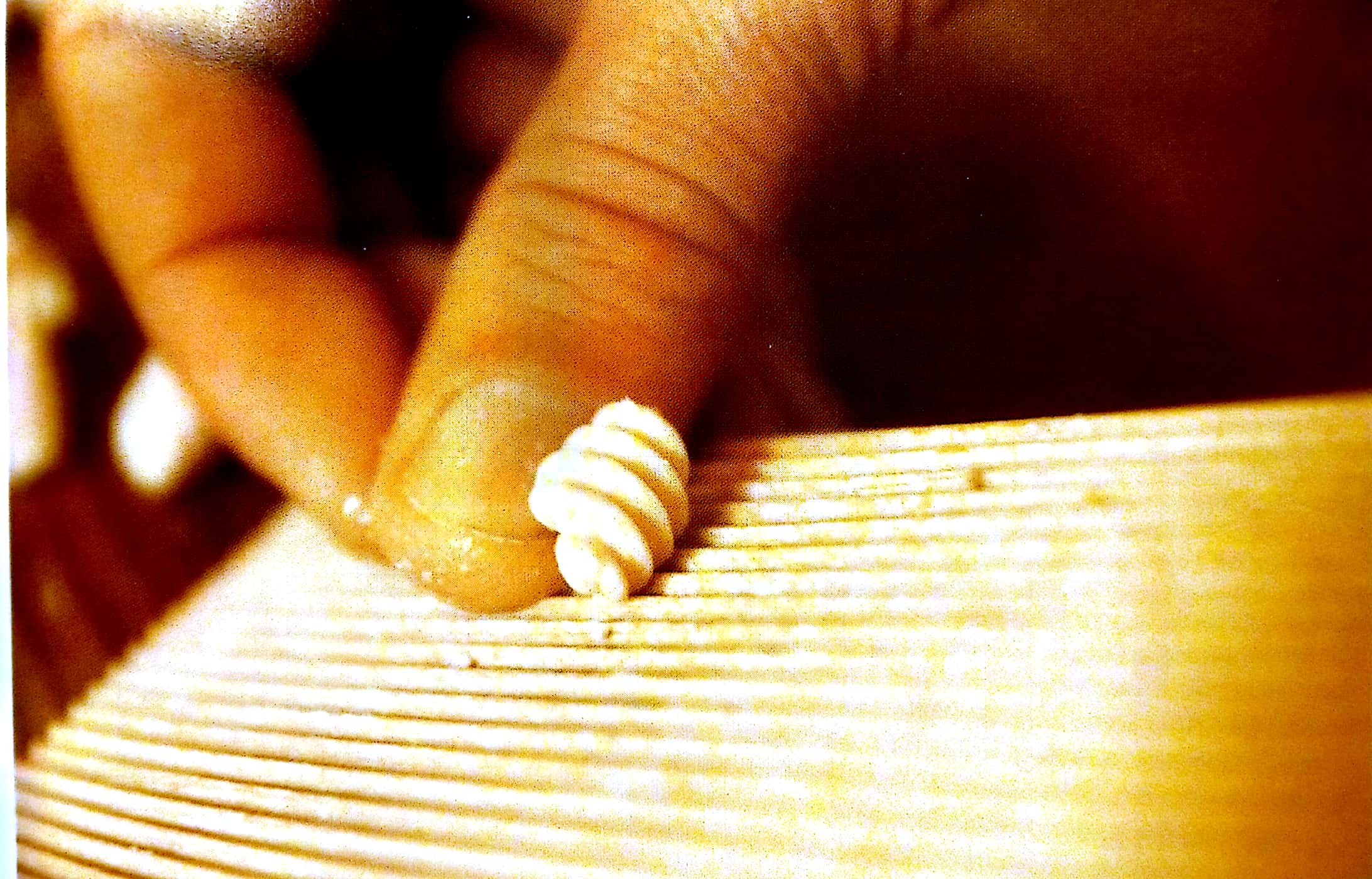Sa cuchina minore no timet su fuste – Simple cuisine make the home great.
Recipes and photographs from “Sweet Myrtle and Bitter Honey” by Efisio Farris.
In Sardinia every friendship begins at the table. There are no strangers, simply friends that are not yet known. It begins with a glass of Cannonau wine and some bread. Conversation follows and the simple pleasures of laughter coupled with simple food make for simple pleasures. It is a Sardinian recipe for happiness and an important lesson that Italians understand perhaps better than any people in the world.
Capensante kin Fregula e Taffranu
Pan-seared Scallops with Fregula and Vegetables
Ingredients
- 2 cups chicken stock
- 2 cups fregula
- 1 bay leaf
- 1 pinch saffron
- 5 tbsp. extra virgin olive oil
- 2 pinches of sea salt
- 2 green onions, chopped
- 1 shallot, chopped
- 1 stalk celery, diced
- 1 zucchini, diced
- 1 yellow squash, diced
- 1 Roma tomato, seeded and diced
- 12 large sea scallops
- 1 bunch arugula, finely chopped
- 1 tablespoon abbamele (Sardinian honey)
Preparation
In a medium saucepan, bring 2 cups of chicken stock to a boil. Add the fregula, bay leaf, saffron, 1 tablespoon olive oil and a pinch of sea salt. Cook covered for 8 to 10 minutes. All of the liquid should be absorbed by the fregula.
Heat 2 tablespoons of olive oil in a medium skillet over a medium flame. Sauté green onions, shallot and celery for 2 to 3 minutes. Add zucchini, squash and tomato. Cook for 2 to 3 minutes. Combine the fregula and vegetables, cook on low heat for another minute. Add additional stock if the mixture is dry.
In a medium nonstick skillet, heat the remaining two tablespoons of olive oil. Cook the scallops until golden and sprinkle with a pinch of sea salt. Turn and brown the other side. Divide the fregula mixture among four plate and top with finely chopped arugula. Top each with three scallops. Finish by drizzling warm abbamele and olive oil.
Malloreddus kin Purpuzza
Baby Bull Pasta with Pancetta and Pork
Malloreddus is a signature pasta in Sardinia, traditionally like baby gnocchi. Nothing goes to waste, so the scrapes – the last bits and trimmings, no larger than a thumbnail, are used to make malloreddus. These small bits of pasta are pressed and rolled against an irregular surface, often a small ribbed piece of wood, to give the pasta its distinctive ridges. The little dumpling-like bites are both chewy and perfect for holding tomato sauce with some grated Sardinian aged pecorino cheese. They are also delicious in a rich meat ragù, or even with a little olive oil and some grated bottarga. You can sometimes find Malloreddus packaged and sold under its Italian name – Gnocchetti Sardi. The preferred flavor for the exported version is saffron.
Ingredients
- 1 lb. pork shoulder, cut into ½” cubes
- 4 oz. pancetta, ½” slices, cut into cubes
- 1 small clove garlic
- 1 pinch freshly ground black pepper
- 2 tsp. red wine vinegar
- ½ cup Terra Saliosa wine (or dry wine)
- 2 oz. sun-dried tomatoes, chopped
- 1 tbsp. tomato paste
- 1 sprig myrtle
- 1 ½ cups chicken stock
- 1 pound malloreddus pasta
- ½ cup grated Pecorino Sardo cheese
- 2 tbsp. extra virgin olive oil
Preparation
Place the pork and pancetta in a large bowl. With a mortar and pestle, mash the garlic and pepper into a paste and add to the bowl with the meat. Mix in the vinegar and coat the pork and pancetta with the marinade. Cover and refrigerate for 4 hours.
Heat a skillet over a medium-high flame and brown the pork and pancetta for 5 minutes. Add the red wine and deglaze the pan. Add the sun-dried tomatoes, tomato paste and myrtle leaves to the skillet, followed by the chicken stock. Cover and simmer for 30 minutes. Bring a large pot of salted water to a boil. Add the malloreddus for 10 minutes to 12 minutes, or until al dente. Remove the myrtle from the sauce and discard. Toss the pasta with the sauce. Sprinkle with pecorino cheese and finish by drizzling with olive oil.
A Brief Glossary of Sardinian Terms
Many elements of Sardinian cooking are unique to the island and may be quite difficult to find in the U.S. The fascinating recipes and tastes are remarkably difficult to reproduce outside of Sardinia. Even the types of foods may leave readers confused. A brief glossary may be useful to navigate the cuisine of Sardinia.
Abbamele – Sardinians are world-renowned experts when it comes to honey. Bees thrive in the climate and the nectar they collect and honey they produce are found in a remarkable array of recipes. Honey is used to flavor virtually every Sardinian signature dish – including the savory ones. You will find a jar of miele millefiori (thousand flower honey) in every home, but two of their honeys are flavored unlike anything else – miele amaro (bitter honey) is made from the pollen of the corbezzolo (strawberry trees). It is a main ingredient in most Sardinian desserts. The other honey is abbathu. This is produced by pressing together honeycombs to extract the honey and pollen together. The liquid is then reduced in copper pots until a thick semi-sweet honey is produced. The result is perfect on everything from salads to ice cream.
Bottarga di muggine is a Sardinian caviar made from the roe of grey mullet. Whole bottarga is very difficult to find in the U.S., but some specialty stores carry a grated version. Try it over a salad of celery and tomatoes.
Casu marzu translates as “rotten cheese.” The FDA would have a field day with this product! The cheese is literally decomposing and alive with maggots (that often jump when disturbed). The maggots create a rich, very soft and creamy Sardinian delicacy that is both subtle and pungent. Although it is officially banned from sale in Italy, you might find it under the counter at a local cheese shop, since it can only be purchased with a wink and a nod!
Cannonau – the red wine of Sardinia. It has become popular in the U.S. in part due to its taste, but also because the unique antioxidants, among other factors, contribute to the extraordinary longevity of Sardinians.
Fregula are small, toasted bits of semolina pasta. The name comes from the Latin ‘fricare’ which means to crumble. That is exactly what it looks like – crumbled bits of handmade pasta. The bits of pasta are dried on a tray and then toasted twice before being ready to eat.
Mirto, the myrtle plant – you may know myrtle as an ornamental garden planting, but in Sardinia it is regularly used in cooking. Like bay leaves, the whole leaf is used to infuse marinades and soups with its spicy, citrusy and bitter flavor. The leaf is then discarded before the dish is served.
Pane – the breads of Sardinia are like a language unto itself. It is synonymous with life itself. There are countless types of bread that are baked on the island. Pane lentu is cooked into a very hot oven until it puffs like a bubble and is then split in half, stacked and covered with linen cloths to be kept warm. It is later toasted to make pane carasau, which is for all intents and purposes, translates as toast! There is moddizzosu, a soft bread made with cooked potatoes and pane e gherda, made with flour, a little oil and bits of pig fat.
Sardo – this soup of fregula with clams is a quintessential Sardinian dish. It uses fish stock, littleneck clams, fregula, Roma tomatoes, garlic, parsley and saffron. Everyone has their own variation, adding a bit more spice, or their own special ingredients and of course, when you are served a bowl in any household in Sardinia, you can rest assured that cook assuredly believes theirs to be the best!





